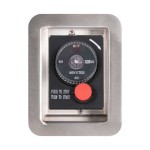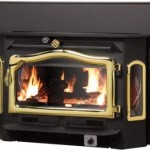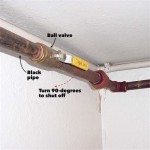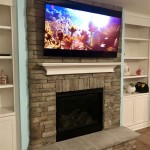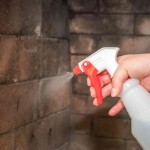Masonry Wood Burning Fireplace Insert: Enhancing Efficiency and Aesthetics
A masonry fireplace, traditionally constructed from brick or stone, offers a classic aesthetic and a comforting source of heat. However, traditional open masonry fireplaces are notoriously inefficient, with a significant portion of the heat generated escaping up the chimney. A masonry wood burning fireplace insert provides a solution, offering improved heating efficiency and a more controlled burn within the existing framework of the fireplace. This article will explore the benefits, considerations, and installation aspects of masonry wood burning fireplace inserts.
A fireplace insert is essentially a self-contained firebox, typically made of steel or cast iron, designed to fit inside an existing masonry fireplace opening. It operates as a closed combustion system, dramatically reducing the amount of heat lost up the chimney and increasing the overall heating efficiency. Unlike open fireplaces, inserts incorporate features such as air controls and baffles to regulate the combustion process and extract more heat from the burning wood.
Key Point 1: Enhanced Heating Efficiency and Reduced Emissions
The primary advantage of installing a masonry wood burning fireplace insert is the significant improvement in heating efficiency. An open fireplace can be as little as 5-15% efficient, meaning that 85-95% of the heat produced is lost up the chimney. In contrast, a modern wood burning fireplace insert can achieve efficiencies of 60-80%, effectively using a much larger percentage of the wood's energy to heat the room.
This increased efficiency translates to several benefits. Firstly, less wood is required to achieve the same level of heating, reducing fuel costs and the labor involved in sourcing and preparing firewood. Secondly, the increased heat output can effectively warm a larger area, potentially supplementing or even replacing the primary heating system in certain spaces. This can lead to significant energy savings, particularly during colder months.
Beyond efficiency, wood burning fireplace inserts are designed to burn cleaner than open fireplaces. Modern inserts incorporate technologies such as catalytic converters and secondary combustion systems to reduce emissions of particulate matter and other pollutants. These technologies ensure a more complete burning process, minimizing the release of harmful substances into the atmosphere and contributing to improved air quality. Many inserts meet stringent EPA (Environmental Protection Agency) standards, ensuring compliance with environmental regulations and promoting responsible wood burning practices.
The closed firebox design also contributes to improved safety. Open fireplaces can release sparks and embers into the room, posing a fire hazard. A fireplace insert contains the fire within a sealed unit, minimizing the risk of stray embers escaping and igniting nearby materials. This provides added peace of mind, particularly in homes with children or pets.
Key Point 2: Considerations for Selecting the Right Insert
Choosing the right masonry wood burning fireplace insert involves several critical considerations. The first is determining the appropriate size of the insert for the existing fireplace opening. This requires accurate measurements of the firebox dimensions, including the width, height, and depth. It is crucial to select an insert that fits comfortably within the opening without being too small or too large. A properly sized insert will ensure optimal performance and prevent potential safety issues.
Another important factor is the heating capacity of the insert, typically measured in BTUs (British Thermal Units). The BTU output should be matched to the size and insulation level of the area it is intended to heat. Consider the square footage of the room or zone, the ceiling height, and the overall insulation of the home. An undersized insert will struggle to provide adequate heat, while an oversized insert may overheat the space and lead to uncomfortable temperatures.
The type of wood that will be burned is also a relevant consideration. Different types of wood have varying heat outputs and burning characteristics. Hardwoods, such as oak and maple, generally produce more heat and burn longer than softwoods, such as pine and fir. Select an insert that is compatible with the types of wood that are readily available and affordable in the local area. It is also essential to ensure that the wood is properly seasoned (dried) before burning to maximize efficiency and minimize smoke production.
Aesthetic preferences also play a role in the selection process. Fireplace inserts are available in a variety of styles and finishes, from traditional cast iron designs to modern stainless steel models. Choose an insert that complements the existing décor of the room and enhances the overall aesthetic appeal of the fireplace. Consider features such as glass doors, decorative surrounds, and optional accessories that can customize the appearance of the insert.
Finally, consider the manufacturer's reputation and the warranty offered on the insert. Opt for a reputable brand with a proven track record of producing high-quality, reliable products. A comprehensive warranty provides protection against defects in materials and workmanship, offering peace of mind and ensuring long-term satisfaction.
Key Point 3: Installation and Maintenance
Proper installation is crucial for the safe and efficient operation of a masonry wood burning fireplace insert. It is strongly recommended to hire a qualified professional installer with experience in installing fireplace inserts. Improper installation can lead to serious safety hazards, including chimney fires, carbon monoxide poisoning, and damage to the fireplace and surrounding structure.
The installation process typically involves several steps. First, the existing fireplace opening is thoroughly cleaned and inspected to ensure it is structurally sound and free of any obstructions. A stainless steel chimney liner is then installed inside the existing chimney flue to provide a safe and efficient venting path for the exhaust gases. The insert is carefully positioned inside the fireplace opening and connected to the chimney liner. Finally, the insert is tested to ensure it is operating correctly and safely.
Regular maintenance is essential for maintaining the performance and longevity of a masonry wood burning fireplace insert. This includes cleaning the insert regularly to remove ash and creosote buildup. Creosote is a flammable substance that can accumulate in the chimney and pose a fire hazard. The frequency of cleaning will depend on the frequency of use and the type of wood being burned, but it is generally recommended to have the chimney inspected and cleaned at least once a year by a qualified chimney sweep.
In addition to cleaning, inspect the insert regularly for any signs of damage or wear. Check the door seals, gaskets, and other components for leaks or deterioration. Replace any worn or damaged parts promptly to prevent performance issues and safety hazards. Follow the manufacturer's recommendations for specific maintenance procedures and schedules.
Proper wood storage is also an important aspect of maintenance. Store firewood in a dry, well-ventilated location to prevent it from becoming damp or moldy. Stack the wood in a way that allows for good air circulation, and avoid storing it directly on the ground. Using properly seasoned wood will ensure a more efficient and cleaner burn, reducing creosote buildup and minimizing the need for frequent cleaning.
The operation of the insert should also be carefully monitored. Ensure that the air controls are properly adjusted to maintain a clean and efficient burn. Avoid overloading the firebox with too much wood, as this can lead to incomplete combustion and increased emissions. Never burn treated wood, painted wood, or other materials that can release harmful chemicals into the air.
By carefully considering these factors and following proper installation and maintenance procedures, homeowners can enjoy the benefits of a masonry wood burning fireplace insert for many years to come. The increased heating efficiency, reduced emissions, and enhanced aesthetic appeal make it a worthwhile investment for those seeking to improve the performance and enjoyment of their existing masonry fireplace.

Get To Know Wood Heaters And Burning Fireplace Inserts Tips

Benefits Of Installing A Wood Burning Fireplace Insert

How Fireplace Inserts Work We Love Fire

Wood Burning Fireplace Inserts Sierra Hearth And Home

Wood Inserts We Love Fire

Fireplace Inserts Everything You Need To Know Full Service Chimney

Superior 48 Inch Masonry Wood Burning Fireplace Wrt8048

Wood Burning Fireplace Insert Frederick Md Repair Install

Wood Burning Fireplace Inserts Sierra Hearth And Home

Do You Know How To Install An Insert In A Masonry Chimney Panadero
Related Posts

